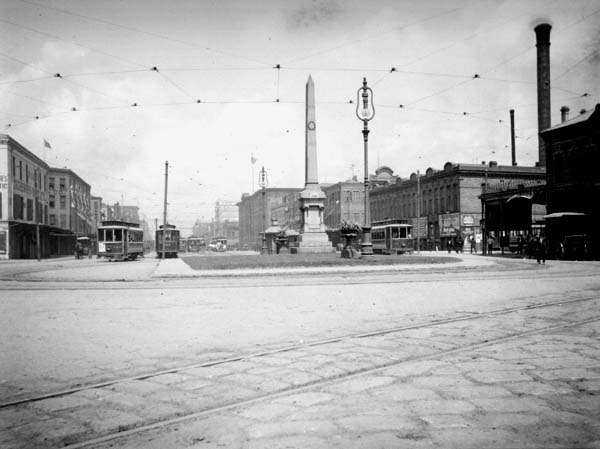 |
| Cantrell |
The proclamation reportedly was set in motion by the Commission for Social Justice, Order Sons and Daughters of Italy in America (OSDIA). The commission approached the mayor's office with the idea and found Cantrell receptive. The mayor appointed Vincenzo Pasquantonio, head of the city's Human Relations Committee, to coordinate with OSDIA. Cantrell, the first woman to serve as mayor of the Crescent City, was inaugurated in May 2018, replacing term-limited Mayor Mitch Landrieu.
Commission Special Counsel Michael A. Santo told reporters the lynchings were "a longstanding wound" for the Italian-American community. "This is something that has to be addressed," he told the Washington Post, praising Mayor Cantrell for her courage.
 |
| Some of the victims |
Chief Hennessy was murdered on his way to his Girod Street home late on the evening of October 15, 1890. He parted from his bodyguard, Captain William O'Connor, about one city square from his residence. A few steps later, gunmen firing from across the street knocked Hennessy down with shotgun loads of birdshot and then closed on their victim, firing high caliber slugs into his body. Hennessy drew his Colt revolver and shot in the direction of his attackers. As the gunmen ran off, O'Connor reached the fallen chief.
 |
| Hennessy |
The police chief died at Charity Hospital the next morning. Suspected members of the Mafia criminal society and their associates were arrested. Eighteen were charged with conspiring in the assassination. Louisiana-born businessman Joseph P. Macheca, Mafia chief Charles Matranga and seven others were the first to be brought to trial in early 1891.
On March 13, the jury acquitted six defendants and could not reach a verdict on the remaining three. The defendants all continued to be held at the Parish Prison - with the others charged in the assassination but not yet tried - pending the expected dismissal of related charges in another court on the Fourteenth.
There were widespread rumors of jury bribery. Civic leaders and a vigilante group known as the Regulators assembled on the night of March 13 and announced a public meeting at the Henry Clay statue (then in the middle of Canal Street at the intersection with Royal and St. Charles) for the next morning:
All good citizens are invited to attend a mass meeting on Saturday, March 14, at 10 o'clock a.m., at Clay Statue, to take steps to remedy the failure of justice in the Hennessy case. Come prepared for action.
Sixty-one prominent citizens signed the meeting call that was published in the morning newspapers. More than half of the signers belonged to one or both of the Crescent City's exclusive social clubs, The Pickwick Club and The Boston Club.
 |
| Mass meeting at Clay statue |
 |
| Battering down door |
The execution squad of about one dozen men moved quickly through the prison, dragged one prisoner outside for hanging, then trapped and shot three prisoners in an upstairs prison hall. Seven prisoners were cornered in the prison yard. As they begged for mercy, the execution squad opened fire with repeating rifles at close range. When one of the targets was found to have survived the shooting, he was dragged outside to be hanged. (Another prisoner, mortally wounded in the shooting in the upstairs hall, remained alive but unconscious for hours.)
 |
| Execution squad |
 |
| Mob swarms Parish Prison |
 |
| Picayune |
 |
| Pittsburgh Dispatch |
According to a press release from the Order Sons and Daughters of Italy in America, the ceremony will begin Friday, April 12, 2019, at 11 a.m. at the American Italian Cultural Center, 537 South Peters Street, just north of Lafayette Street. The Commission for Social Justice is the anti-defamation arm of the OSDIA. The commission was formed in 1979. OSDIA's roots stretch back to 1905 in New York City. The American Italian Cultural Center was founded in New Orleans as the American Italian Renaissance Foundation Museum and Research Library by the late Joseph Maselli (1924-2009).
The website of the New Orleans mayor provides no information about the anticipated apology. The American Italian Cultural Center's website is promoting this special event. The center is also selling tickets to an Italian community dinner on the eve of the mayor's proclamation.
See also:
- Hunt, Thomas, and Martha Macheca Sheldon, Deep Water: Joseph P. Macheca and the Birth of the American Mafia, Second Edition, Createspace, 2018.
- "1891 grand jury indicts bribers, defends killers," Writers of Wrongs, May 5, 2018.
- "New Orleans police chief ambushed, murdered," Writers of Wrongs, Oct. 15, 2017.
- "Disturbance at trial of Hennessy assassins," Writers of Wrongs, March 2, 2017.
- "$5,000 awarded to family of lynch victim," Writers of Wrongs, Jan. 13, 2017.
Sources:
- "Mayor to apologize for 191 lynching of 11 Italian Americans," New York Times, nytimes.com, March 30, 2019.
- "Official Proclamation of Apology by the Mayor of New Orleans to the Italian American Community for America's Largest Single Mass Lynching," PRWeb, prweb.com, April 2, 2019.
- Daugherty, Owen, "New Orleans mayor to apologize to Italian-Americans for 1891 lynchings," The Hill, thehill.com, April 1, 2019.
- Feldman, Kate, "New Orleans mayor to apologize to Italian-Americans for 1891 lynchings that killed 11 immigrants," New York Daily News, nydailynews.com, April 1, 2019.
- Flynn, Meagan, "New Orleans to apologize for lynching of 11 Italians in 1891, among worst in American history," Washington Post, April 1, 2019.
- McConnaughey, Janet, "New Orleans mayor plans apology for 'longstanding wound' of 1891 Italian immigrant lynchings," New Orleans Advocate, theadvocate.com, March 30, 2019.
- Prior, Ryan, "128 years later, New Orleans is apologizing for lynching 11 Italians," CNN, cnn.com, April 1, 2019.
- Santo, Michael A., Esq., "Presentation of an Official Proclamation of Apology by the Mayor of New Orleans to the Italian American Community," We the Italians, wetheitalians.com, March 25, 2019.


















